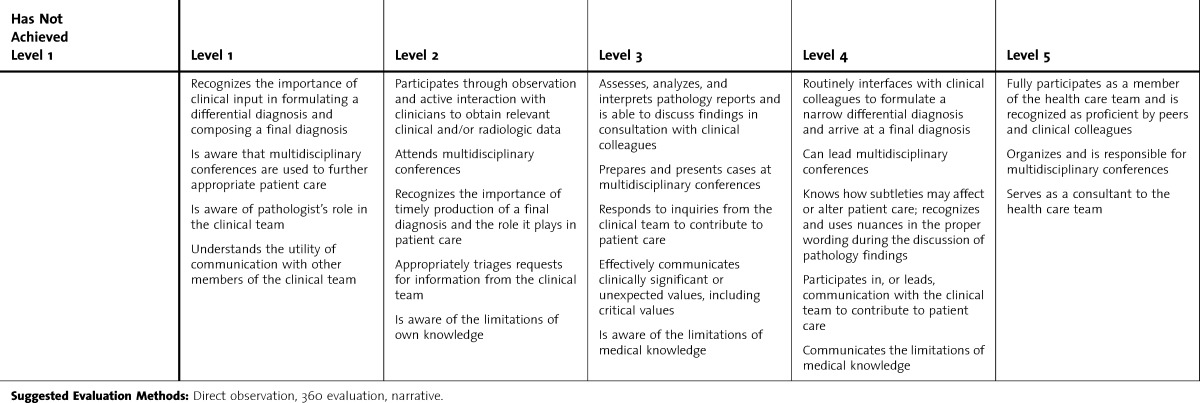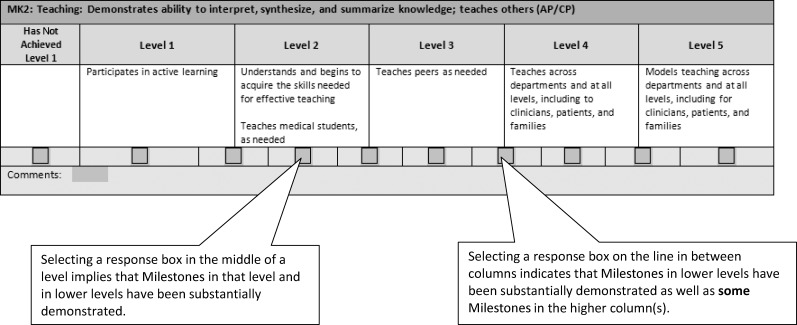The Milestones provide a framework for the assessment of the development of the resident physician in key dimensions of the elements of physician competency in a specialty or subspecialty. The Milestones are designed only for use in evaluation of resident physicians in the context of their participation in Accreditation Council for Graduate Medical Education (ACGME)–accredited residency or fellowship programs. They neither represent the entirety of the dimensions of the 6 domains of physician competency, nor are they designed to be relevant in any other context.
Milestone Reporting
This document presents Milestones designed for programs to use in semiannual review of resident performance and reporting to ACGME. Milestones are knowledge, skills, attitudes, and other attributes for each of the ACGME competencies organized in a developmental framework from less to more advanced. They are descriptors and targets for resident performance as a resident moves from entry into residency through graduation. In the initial years of implementation, the Review Committee will examine Milestone performance data for each program's residents as 1 element in the Next Accreditation System (NAS) to determine whether residents overall are progressing.
For each reporting period, review and reporting will involve selecting the level of Milestones that best describes each resident's current performance level in relation to the Milestones. Milestones are arranged into numbered levels. Selection of a level implies that the resident substantially demonstrates the Milestones at that level, as well as those in lower levels (see figure). A general interpretation of each level for pathology is below:
FIGURE.
Example Set of Milestones for 1 Subcompetency in the ACGME Milestone Report Form
Level 1: The resident is a graduating medical student/experiencing first day of residency.
Level 2: The resident is advancing and demonstrating additional Milestones.
Level 3: The resident continues to advance and demonstrate additional Milestones; the resident consistently demonstrates most of the Milestones targeted for residency.
Level 4: The resident has advanced so that he or she now substantially demonstrates the Milestones targeted for residency. This level is designed as the graduation target.
Level 5: The resident has advanced beyond performance targets set for residency and is demonstrating aspirational goals that might describe the performance of someone who has been in practice for several years. It is expected that only a few exceptional residents will reach this level.
Additional Notes
Level 4 is designed as the graduation target but does not represent a graduation requirement. Making decisions about readiness for graduation is the purview of the residency program director. (See the NAS Frequently Asked Questions for educational Milestones on the ACGME's website for further discussion of this issue: “Can a resident graduate if he or she does not reach every Milestone?”) Study of Milestone performance data will be required before the ACGME and its partners will be able to determine whether Level 4 Milestones and Milestones in lower levels are at the appropriate level within the developmental framework and whether Milestone data are of sufficient quality to be used for high-stakes decisions.
Some Milestone descriptions include statements about performing independently. These activities must follow the ACGME supervision guidelines. For example, a resident who performs a procedure or takes independent calls must, at a minimum, be supervised through oversight.
ACGME Milestone Report Form
The figure presents an example set of Milestones for 1 subcompetency in the same format as the Milestone Report Form. For each reporting period, a resident's performance on the Milestones for each subcompetency will be indicated by:
selecting the level of Milestones that best describes the resident's performance in relation to the Milestones, or
selecting the “Has Not Achieved Level 1” option.
PATHOLOGY MILESTONES - Patient Care (PC)
TABLE 1.
PC1. Consultation: Analyzes, Appraises, Formulates, Generates, and Effectively Reports Consultation (Anatomic Pathology [AP] and Clinical Pathology [CP])
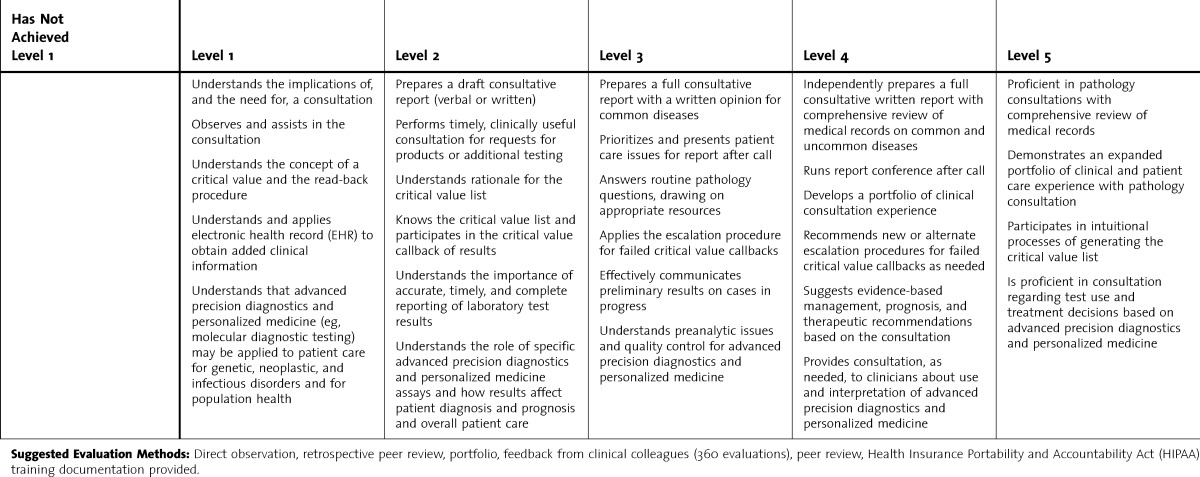
TABLE 2.
PC2. Interpretation and Reporting: Analyzes Data and Appraises, Formulates, and Generates Effective and Timely Reports (Clinical Pathology [CP])

TABLE 3.
PC3. Interpretation and Diagnosis: Demonstrates Knowledge and Practices Interpretation and Analysis to Formulate Diagnoses (Anatomic Pathology [AP])

TABLE 4.
PC4. Reporting: Analyzes Data and Appraises, Formulates, and Generates Effective and Timely Reports (Anatomic Pathology [AP])
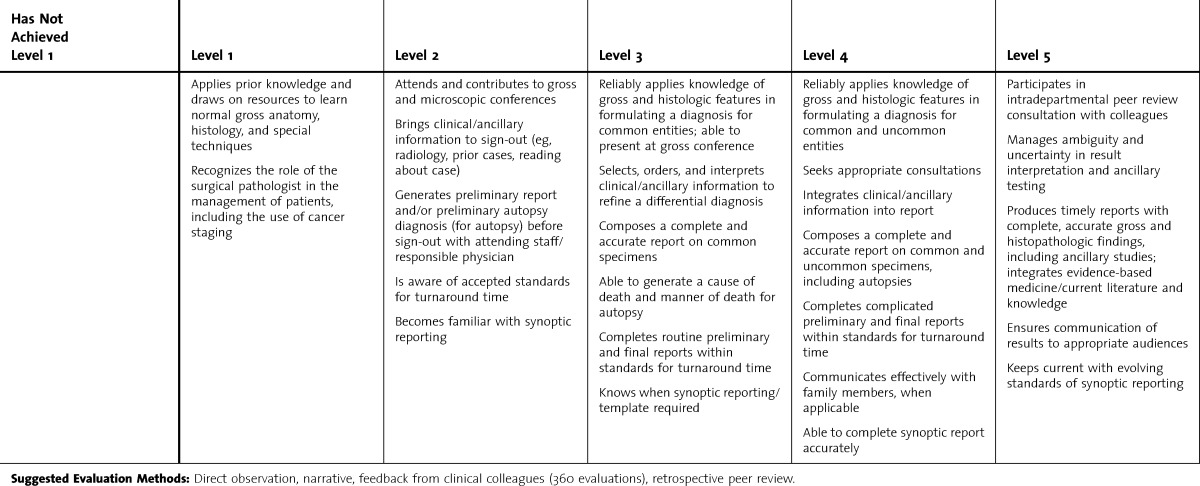
TABLE 5.
PC5. Procedure: Surgical Pathology Grossing: Demonstrates Attitudes, Knowledge, and Practices that Enable Proficient Performance of Gross Examination (Analysis and Appraisal of Findings, Synthesis and Assembly, and Reporting) (Anatomic Pathology [AP])
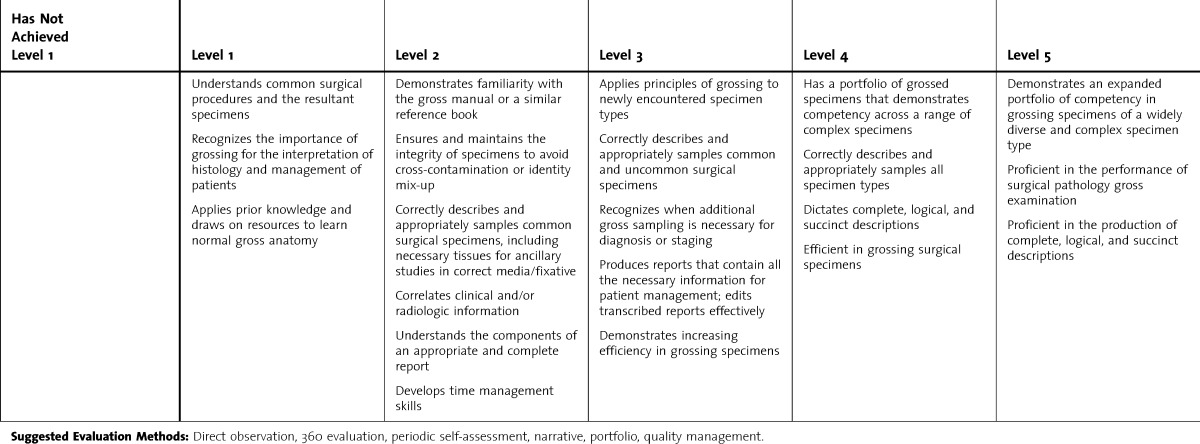
TABLE 6.
PC6. Procedure: Intraoperative Consultation/ Frozen Sections: Demonstrates Attitudes, Knowledge, and Practices that Enables Proficient Performance of Gross Examination and Frozen Section (Analysis and Appraisal of Findings, Synthesis and Assembly, and Reporting) (Anatomic Pathology [AP])
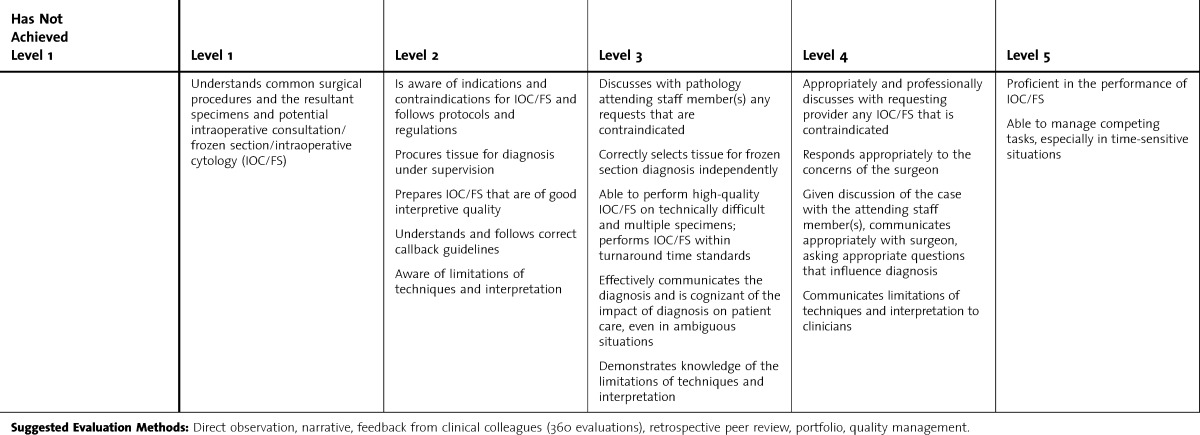
TABLE 7.
PC7. Procedures: If Program Teaches Other Procedures (eg, Bone Marrow Aspiration, Apheresis, Fine-Needle Aspiration (FNA) Biopsy, Ultrasound-Guided FNA, etc) (Anatomic Pathology [AP] and Clinical Pathology [CP])
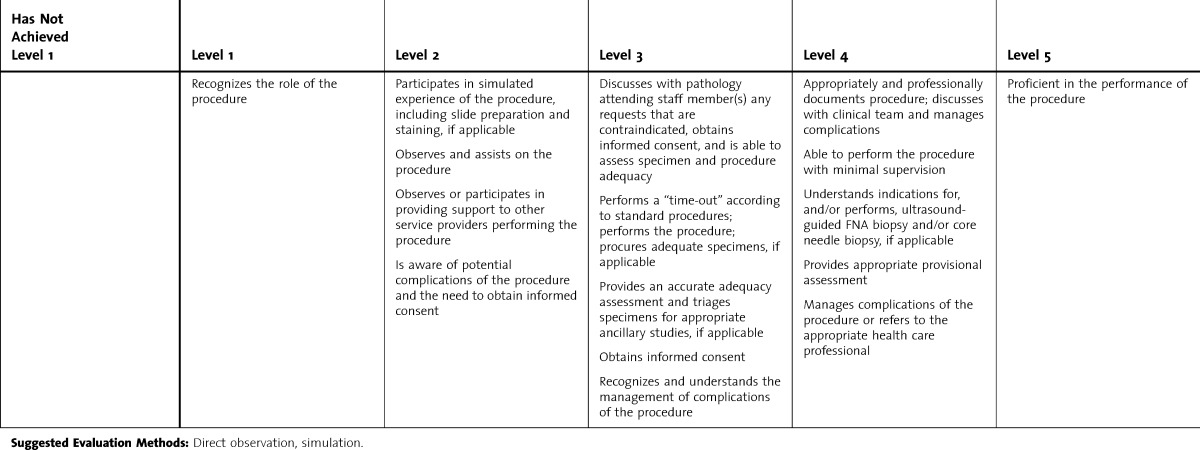
Medical Knowledge (MK)
TABLE 8.
MK1. Diagnostic Knowledge: Demonstrates Attitudes, Knowledge, and Practices that Incorporate Evidence-Based Medicine and Promote Lifelong Learning (Anatomic Pathology [AP] and Clinical Pathology [CP])

TABLE 9.
MK2. Teaching: Demonstrates Ability to Interpret, Synthesize, and Summarize Knowledge; Teaches Others (Anatomic Pathology [AP] and Clinical Pathology [CP])

TABLE 10.
MK3. Procedure: Autopsy: Demonstrates Knowledge and Practices that Enable Proficient Performance of a Complete Autopsy (Analysis and Appraisal of Findings, Synthesis and Assembly, and Reporting) (Anatomic Pathology [AP])
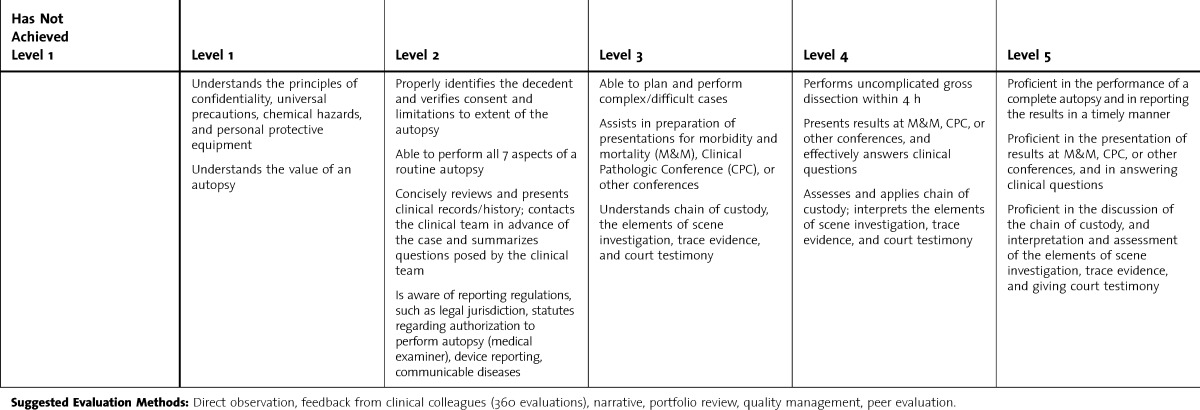
Systems-Based Practice (SBP)
TABLE 11.
SBP1. Patient Safety: Demonstrates Attitudes, Knowledge, and Practices that Contribute to Patient Safety (Anatomic Pathology [AP] and Clinical Pathology [CP])

TABLE 12.
SBP2. Laboratory Management: Regulatory and Compliance: Explains, Recognizes, Summarizes, and is Able to Apply Regulatory and Compliance Issues (Anatomic Pathology [AP] and Clinical Pathology [CP])
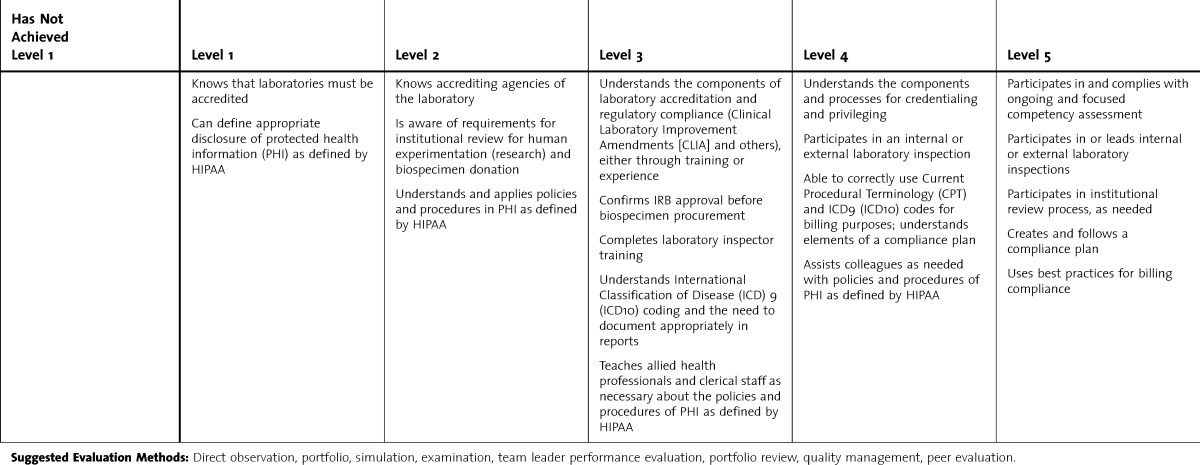
TABLE 13.
SBP3. Laboratory Management: Resource Use (Personnel and Finance): Explains, Recognizes, Summarizes, and Is Able to Apply Resource Use Principles (Anatomic Pathology [AP] and Clinical Pathology [CP])

TABLE 14.
SBP4. Laboratory Management: Quality, Risk Management, and Laboratory Safety: Explains, Recognizes, Summarizes, and Is Able to Apply Quality Improvement, Risk Management, and Safety Issues (Anatomic Pathology [AP] and Clinical Pathology [CP])

TABLE 15.
SBP5. Laboratory Management: Test Use: Explains, Recognizes, Summarizes, and Is Able to Apply Test Use (Anatomic Pathology [AP] and Clinical Pathology [CP])

TABLE 16.
SBP6. Laboratory Management: Technology Assessment: Explains, Recognizes, Summarizes, and Is Able to Apply Technology Assessment (Anatomic Pathology [AP] and Clinical Pathology [CP])

TABLE 17.
SBP7. Informatics: Explains, Discusses, Classifies, and Applies Clinical Informatics (Anatomic Pathology [AP] and Clinical Pathology [CP])

Practice-Based Learning and Improvement (PBLI)
TABLE 18.
PBLI1. Recognition of Errors and Discrepancies: Displays Attitudes, Knowledge, and Practices That Permit Improvement of Patient Care From Study of Errors and Discrepancies (Anatomic Pathology [AP] and Clinical Pathology [CP])

TABLE 19.
PBLI2. Scholarly Activity: Analyzes and Appraises Pertinent Literature, Applies Scientific Method to Identify and Interpret Evidence-Based Medicine and to Apply It Clinically (Anatomic Pathology [AP] and Clinical Pathology [CP])

Professionalism (PROF)
TABLE 20.
PROF1. Licensing, Certification, Examinations, Credentialing: Demonstrates Attitudes and Practices That Ensure Timely Completion of Required Examinations and Licensure (Anatomic Pathology [AP] and Clinical Pathology [CP])

TABLE 21.
PROF2. Professionalism: Demonstrates Honesty, Integrity, and Ethical Behavior (Anatomic Pathology [AP] and Clinical Pathology [CP])

TABLE 22.
PROF3. Professionalism: Demonstrates Responsibility and Follow-Through on Tasks (Anatomic Pathology [AP] and Clinical Pathology [CP])

TABLE 23.
PROF4. Professionalism: Gives and Receives Feedback (Anatomic Pathology [AP] and Clinical Pathology [CP])

TABLE 24.
PROF5. Professionalism: Demonstrates Responsiveness to Each Patient's Unique Characteristics and Needs (Anatomic Pathology [AP] and Clinical Pathology [CP])

TABLE 25.
PROF6. Professionalism: Demonstrates Personal Responsibility to Maintain Emotional, Physical, and Mental Health (Anatomic Pathology [AP] and Clinical Pathology [CP])

Interpersonal and Communication Skills (ICS)
TABLE 26.
ICS1. Intradepartmental Interactions and Development of Leadership Skills: Displays Attitudes, Knowledge, and Practices That Promote Safe Patient Care Through Team Interactions and Leadership Skills Within the Laboratory (Anatomic Pathology [AP] and Clinical Pathology [CP])
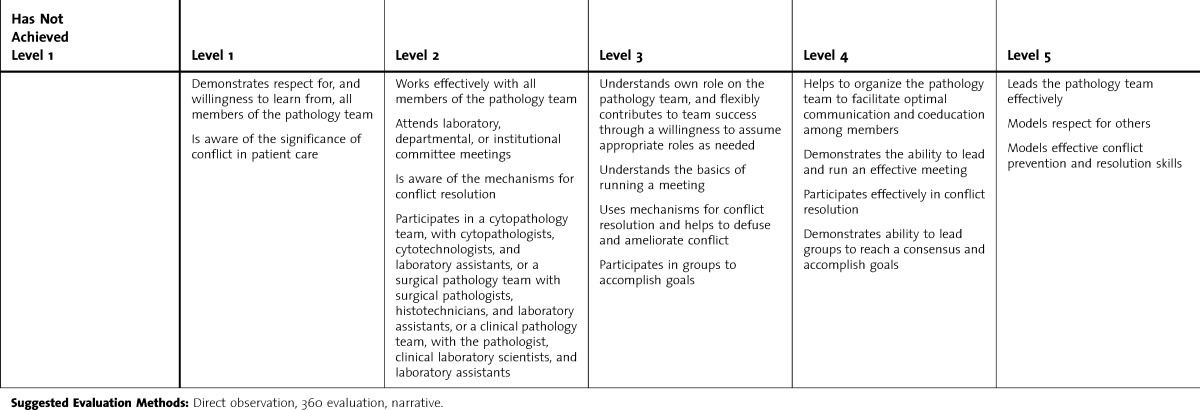
TABLE 27.
ICS2. Interdepartmental and Health Care Clinical Team interactions: Displays Attitudes, Knowledge, and Practices That Promote Safe Patient Care Through Interdisciplinary Team Interactions (Anatomic Pathology [AP] and Clinical Pathology [CP])
